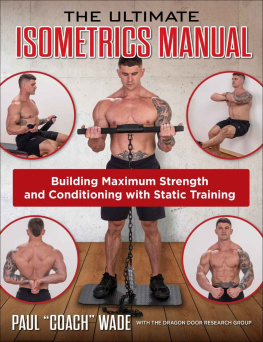Isometrics: For Strength, For Power, For Speed, and For the WIN - Special Report #1 Strength and Power
Im going to show you how:
- Isometrics are a form of resistance exercise involving intense muscle contractions?
- They require no, little, found or standard resistance equipment to generate incredible strength loads?
- They need no movement to produce amazing strength results because they consist of static contractions?
Possibly youve wondered how this can be?
Surely, to gain strength and muscle, your limbs must move through a range of motion to achieve a definite productive result, right?
Nope.
But surely ONLY dynamic lowering/ raising/ lowering reps can build strength and muscle?
Ah but nope again!
Hello, my name is Russell Wilks and Im a writer, author, novelist, strength coach and information products entrepreneur.
In this Special Report Im going to show you that the secret to all strength building is in the quality and intensity of contraction and NOT in the movement of muscles. Or in the amount of reps and sets (volume) you do.
And Im going to show you how you can use Isometric Training in your life to get MUCH Stronger, densify your musculature and produce amazing strength, muscle, health and sportive benefits.
But Surely Your Muscles Must Move Through a Full Range of Motion to Build Strength?
Nope
You see when your muscles encounter a load. Or are placed under a load. They contract. They dont need to move to experience this contraction. It is the encounter with resistance that causes it. The heavier the resistance, the greater the contraction.
That contraction can be self-generated (self-resisted). It can be from working against objects. Or it can be generated by using weighted, measurables progressive resistances.
Depending upon the strength or intensity of this contraction, large-scale, full-range muscle movement can be detrimental to maximum strength-building because of your strength ranges and phases that Ill go into more as we go along.
Forget common gym memes for now.
With an isometric theres very little movement around the joint angle. Perhaps some slight change at a microscopic level within your musculature. But theres no real movement of the joint. The chosen angle stays the same.
Depending on how heavy the load is, dictates how intense (strong) your contraction will be.
A light load brings about a minor contraction.
A very heavy load demands a very heavy contraction (a maximum contraction).
Load in the form of weight, resistance etc. is efficiently gauged and adapted to by your Central Nervous System (CNS).
As your strength levels are governed by the state of your CNS, you can see that a healthy, vital organism (yours) lifts more, runs more, does more, at a potentially higher output (intensity). Regardless of your age or ability etc.
In isometric exercise a load can be generated 3 Ways:
1) A Self-Resisted Contraction (Against Your Own Body)
2) Using Objects (Against Chains, Static Frames, Buildings, Towels Etc.)
3) Using Measurable Equipment and Devices (Weights, Resistance Bands, Strands Cables, Dynameters Etc.)
Regardless of how the contraction is generated, its strength is governed by its intensity (resistance).
The level of resistance (load) you encounter, dictates how many motor units your central nervous system must allocate to the task of countering and coping with it.
The stronger the perceived load, the more intense the contraction produced. Because of this stronger contraction, your CNS must allocate greater amounts of motor units to cope with the heaviness of the load.
All resistance is gauged as such, by your Central Nervous System. Your CNS governs how many motor units to allocate to resist the load. And how strong you can be under specific circumstances.
To get stronger you must push your CNS to adapt to greater resistances. As there is a current natural limit to what you can lift, move etc. Part of this is just progressive practice. And part is the strength brakes placed upon you under normal operation (more later).
If normally 100 kgs is the maximum you could move or resist in a deadlift. That would be your current strength (your maximum) with that lift - Youd be currently capped at that level.
So, if you tried to lift 300 kgs in a deadlift. Having only ever done 100 kgs. Its likely youd fail - Because your CNS hasnt so far been trained to accept that that resistance is doable.
Your muscles etc. wouldnt be able to lift or resist it - Because theyre just not used to that level of contraction, yet.
Normally, the key principle of weight training is progressive resistance. In that last week you lift 100 kgs as your max. This week you do 101 kgs for the same lift etc.
There are a few shortcuts that quickly get past or increase this strength cap markedly. Isometrics are one of them. Because its possible to contract your muscles much harder than theyve ever done through standard weight training - Using a self-resisted, object-resisted or a progressive-resistance isometric technique to resist far greater loads.
A more intense contraction causes a greater and reaction and adaptation.
Once youve rested enough to compensate for the beyond normal exertion, youre potentially a lot stronger than you were before it.
This is merely cranking up your internal meter. The strength potential is already within you as proven by the exceptions to the strength cap ruleWhen youre under extreme emotional duress. Or youve been electrocuted, which could be classed as the same thing (more later).
For now, though, heres a simple example of how your CNS gauges pressure/ force-resistance.
Lets say your maximum barbell curl (your 1 Rep Max) is 100 kgs. And you pick up 10 kgs - Your Central Nervous System (CNS) is barely troubled to send any motor units at all - Because the weight is very light compared to what its used to.
But, the heavier the load (resistance) or the longer it is held for (time), the more motor units are needed to cope with the systemic demand.
Lets say you now do a barbell curl with 100 kgs, which is your current 1 Rep Max. Now your CNS must send a large crew of motor units to cope with the heaviness of the load.
But, because this is your 1 Rep Max, your CNS only need send the same amount of motor units as last time to deal with the challenge - Its used to dealing with 100 kgs as your maximum 1 Rep Curl because its done it before. And it recognises that 100 kgs is around your maximum for that lift.
This illustrates an important point:
The way to get stronger is to force your CNS to allocate greater amounts of motor units to the task by resisting greater loads (progressive resistance (overload))
Ideally once you can lift 100 kgs in a barbell curl youd rachet up to 105 kgs. And so on. Progressing in a systematic manner to 150 kgs, 175 kgs etc.
If you get enough quality sleep, rest, nutrition and recovery, all will generally progress.
Primarily your CNS judges the heaviness of the load. When you curl 105 kgs your CNS MUST allocate greater amounts of motor units to resisting that load. Because this represents a new experience for it. It has not, until now, resisted this much weight, like that.
As well as the heaviness of the load, you can make each lift harder (greater effort) through other means, without increasing the load, yet.
In the bicep curl example your CNS is forced to allocate more motor units to the task at hand IF you:
1) Increase the weight/ load/ resistance BEYOND your current recorded capability (LOAD-RESISTANCE)
So, when you put 105 kgs on the bar and lifted or resisted it in a curl, your CNS must allocate more motor units to the task than it did last time - Because the load is heavier than before.
Next page










